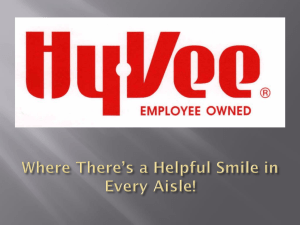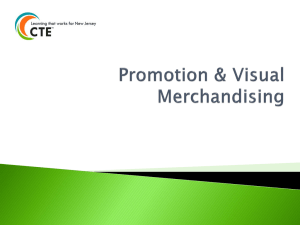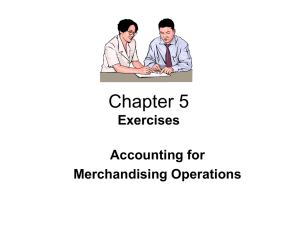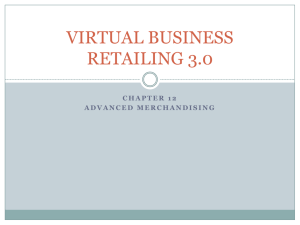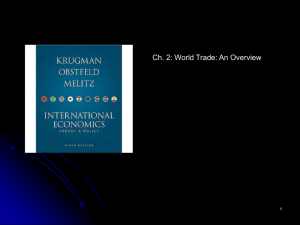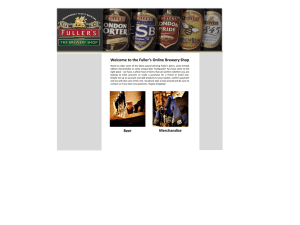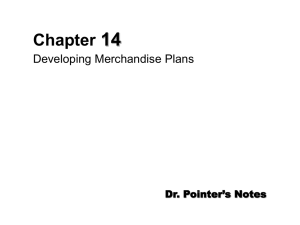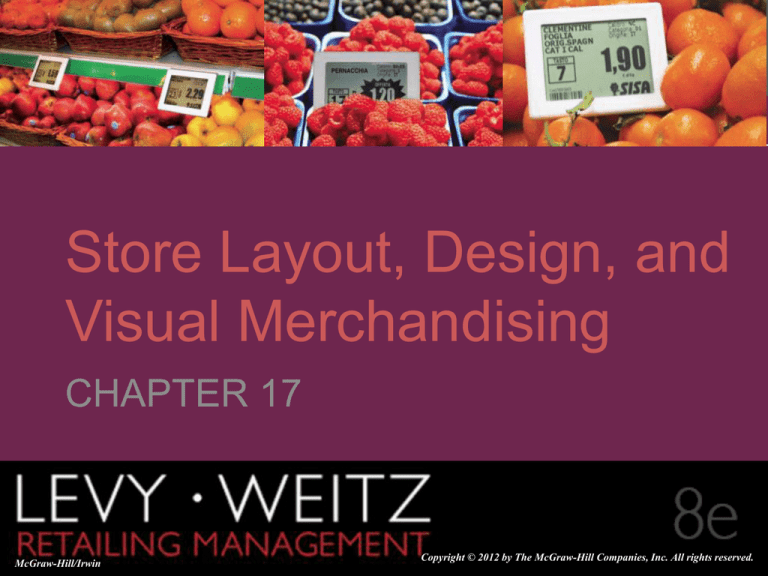
CHAPTER
CHAPTER17
2
1
Store Layout, Design, and
Visual Merchandising
CHAPTER 17
Retailing
Management 8e
McGraw-Hill/Irwin
© 2012 All
by The
McGraw-Hill
Companies, Inc. All rights reserved.
17 © The McGraw-HillCopyright
Companies,
rights
reserved.
Store Design Objectives
CHAPTER
CHAPTER17
2
1
• Implement Retailer’s strategy
• Build Loyalty
• Increase Sales on Visits
• Control Cost
• Legal Considerations—Americans with Disabilities
Act
• Design Trade-Offs
17-
Store Design and Retail Strategy
CHAPTER
CHAPTER17
2
1
The primary objective of store design is implementing the retailer’s strategy
(c) Brand X Pictures/PunchStock
Meets needs of target market
Builds a sustainable competitive advantage
Displays the store’s image
C. Borland/PhotoLink/Getty Images
17-
Build Loyalty
CHAPTER
CHAPTER17
2
1
• Store design provides utilitarian benefits when it
enables customers to locate and purchase products
in an efficient and timely manner with minimum
hassle
• Store design provides hedonic benefits by offering
customers an entertaining and enjoyable shopping
experience.
H. Wiesenhofer/PhotoLink/Getty Images
17-
Increase Sales on Visits
CHAPTER
CHAPTER17
2
1
• Store design has a substantial effect on which
products customers buy, how long they stay in the
store, and how much they spend during a visit.
17-
Control Cost
CHAPTER
CHAPTER17
2
1
• Control the cost of implementing the store design
and maintain the store’s appearance
• Store design influences
• Shopping experience and thus sales
• Labor costs
• Inventory shrinkage
17-
Legal Considerations
CHAPTER
CHAPTER17
2
1
• Americans with Disabilities Act (ADA)
• Protects people with disabilities from
discrimination in employment, transportation,
public accommodations, telecommunications and
activities of state and local government
• Affects store design as disabled people need
“reasonable access” to merchandise and services
built before 1993. After 1993, stores are
expected to be fully accessible.
17-
Reasonable Access
What does that mean?
• 32 inch wide pathways on the
main aisle and to the
bathroom, fitting rooms
elevators and around most
fixtures
• Lower most cash wraps and
fixtures so they can be
reached by a person in a
wheelchair
• Make bathroom and fitting
room fully accessible
CHAPTER
CHAPTER17
2
1
Keith Brofsky/Getty Images
17-
Store Design Elements
CHAPTER
CHAPTER17
2
1
• Layouts
• Signage and
Graphics
• Feature Area
17-
Store Layouts
CHAPTER
CHAPTER17
2
1
• To encourage customer exploration and help
customers move through the stores
• Use a layout that facilitates a specific traffic
pattern
• Provide interesting design elements
• Types of Store Layouts
• Grid
• Racetrack
• Free Form
17-
Grid Layout
CHAPTER
CHAPTER17
2
1
• Easy to locate merchandise
• Does not encourage
customers to explore store
• Limited site lines to merchandise
• Allows more merchandise
to be displayed
• Cost efficient
• Used in grocery, discount,
and drug stores: Why?
17-
Racetrack Layout (Loop)
CHAPTER
CHAPTER17
2
1
• Loop with a major aisle that has access to
departments
• Draws customers around the store
• Provide different viewing angles and encourage
exploration, impulse buying
• Used in department stores
17-
JCPenney Racetrack Layout
CHAPTER
CHAPTER17
2
1
17-
Free-Form (Boutique) Layout
CHAPTER
CHAPTER17
2
1
• Fixtures and aisles arranged
asymmetrically
• Provides an intimate, relaxing environment
that facilitates shopping and browsing
• Pleasant relaxing ambiance doesn’t come
cheap – small store experience
• Inefficient use of space
• More susceptible to shoplifting –
salespeople can not view adjacent
spaces.
• Used in specialty stores and upscale
department stores
17-
Usage of Signage and Graphics
CHAPTER
CHAPTER17
2
1
• Location – identifies the location of merchandise and guides customers
• Category Signage – identifies types of products and located near the
goods
• Promotional Signage – relates to specific offers – sometimes in windows
• Point of sale – near merchandise with prices and product information
• Lifestyle images – creates moods that encourage customers to shop
17-
Digital Signage
CHAPTER
CHAPTER17
2
1
Visual Content delivered digitally through a centrally managed
and controlled network and displayed on a TV monitor or flat
panel screen
•Superior in attracting attention
•Enhances store environment
•Provides appealing atmosphere
•Overcomes time-to-message hurdle
•Messages can target demographics
•Eliminates costs with printing, distribution and installing
traditional signage
17-
Feature Areas
CHAPTER
CHAPTER17
2
1
• Areas within a store designed to
get the customers’ attention
• Feature areas
• Entrances
• Freestanding displays
• Cash wraps (POP counters, checkout
areas)
• End caps
• Promotional aisles
• Walls
• Windows
• Fitting rooms
PhotoLink/Getty Images
17-
Location of Merchandise Categories
CHAPTER
CHAPTER17
2
1
• Impulse merchandise – near heavily trafficked
areas
• Demand/Destination merchandise – back left-hand
corner of the store
• Special merchandise – lightly trafficked areas (glass
pieces, women’s lingerie)
• Adjacencies – cluster complimentary merchandise
next to each other
17-
Location of Merchandise within a Category: The Use
of Planograms
CHAPTER
CHAPTER17
2
1
• Supermarkets and drug stores place private-label brands to the right of
national brands – shoppers read from left to right (higher priced national
brands first and see the lower-priced private-label item)
• Planogram: a diagram that shows how and where specific SKUs should
be placed on retail selves or displays to increase customer purchases
17-
Learning customers’ movements
and decision-making
CHAPTER
CHAPTER17
2
1
• Videotaping Consumers
• Learn customers’ movements, where they pause or move
quickly, or where there is congestion
• Evaluate the layout, merchandise placement, promotion
• Virtual Store Software
• Learn the best place
to merchandise and
test how customers
react to new products
17-
Visual Merchandising: Fixtures
CHAPTER
CHAPTER17
2
1
A. Straight rack
B. Rounder (bulk
fixture, capacity
fixture)
C. Four-way fixture
(feature fixture)
D. Gondolas
17-
Straight Rack
CHAPTER
CHAPTER17
2
1
Royalty-Free/CORBIS
• Holds a lot of apparel
• Hard to feature specific styles
and colors
• Found often in discount and offprice stores
17-
Rounder
CHAPTER
CHAPTER17
2
1
• Smaller than straight
rack
• Holds a maximum
amount of
merchandise
• Easy to move around
• Customers can’t get
frontal view of
merchandise
17-
Four-Way
CHAPTER
CHAPTER17
2
1
• Holds large amount
of merchandise
• Allows customers to
view entire garment
• Hard to maintain
because of styles
and colors
• Fashion oriented
apparel retailer
17-
Gondolas
CHAPTER
CHAPTER17
2
1
• Versatile
• Grocery and discount stores
• Some department stores
• Hard to view apparel as they
are folded
Royalty-Free/CORBIS
17-
Idea-Orientation Presentation
CHAPTER
CHAPTER17
2
1
• Present merchandise
based on a specific idea
or the image of the store
• Encourage multiple
complementary
purchases
• Women’s fashion
• Furniture combined in
room settings
• Sony Style mini-living
rooms
17-
Creating an Appealing Store Atmosphere
CHAPTER
CHAPTER17
2
1
The design of an environment through visual
communications, lighting, colors, music, and scent to
stimulate customers’ perceptual and emotional responses
and ultimately to affect their purchase behavior
17-
Lighting
CHAPTER
CHAPTER17
2
1
• Highlight merchandise
• Structure space and capture a mood
• Energy efficient lighting
• Downplay features
The McGraw-Hill Companies, Inc./Lars A. Niki, photographer
17-
Color
CHAPTER
CHAPTER17
2
1
• Warm colors (red, gold,
yellow) produce emotional,
vibrant, hot, and active
responses
• Cool colors (white, blue,
green) have a peaceful,
gentle, calming effect
• Culturally bounded
• French-Canadians – respond
more to warm colors
• Anglo-Canadians – respond
more to cool colors
The McGraw-Hill Companies, Inc./Lars Niki, photographer
17-
Music
CHAPTER
CHAPTER17
2
1
• Control the pace of store traffic, create an image,
and attract or direct consumers’ attention
• A mix of classical or soothing music encourage
shoppers
• to slow down, relax, and take a good look at the
merchandise
• thus to stay longer and purchase more
17-
Scent
CHAPTER
CHAPTER17
2
1
• Has a positive impact
on impulse buying
behavior and customer
satisfaction
• Scents that are neutral
produce better
perceptions of the store
than no scent
• Customers in scented
stores think they spent
less time in the store
than subjects in
unscented stores
The McGraw-Hill Companies, Inc./Gary He, photographer
17-

